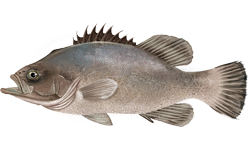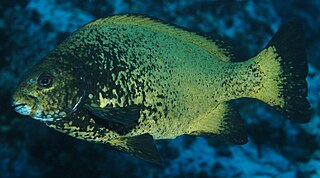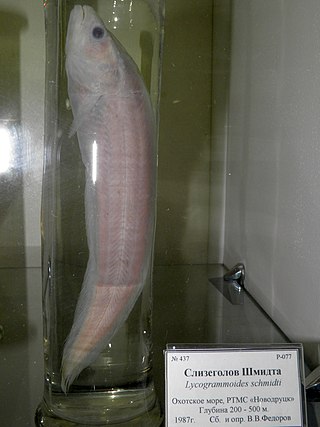The eelpouts are the ray-finned fish family Zoarcidae. As the common name suggests, they are somewhat eel-like in appearance. All of the roughly 300 species are marine and mostly bottom-dwelling, some at great depths. Eelpouts are predominantly found in the Northern Hemisphere. The arctic, north pacific and north Atlantic oceans have the highest concentration of species, however species are found around the globe.

Acropomatidae is a family of fish in the order Perciformes, commonly known as lanternbellies. Acropoma species are notable for having light-emitting organs along their undersides. They are found in all temperate and tropical oceans, usually at depths of several hundred meters. There are about 32 species in as many as 9 genera, although some authorities recognise fewer genera than Fishbase does.

Holacanthus is a genus of marine angelfishes. The eight species are particularly abundant near volcanic rocks and coral islands. Some are highly valued as food, but even more so for aquaria, as all are brightly colored.

The wreckfish are a family, Polyprionidae in the suborder Percoidei of the order Perciformes.

The sea chubs, also known as rudderfish and pilot fish and in Hawaiian as enenue or nenue, are a family, Kyphosidae, of fishes in the order Perciformes native to the Atlantic, Indian and Pacific Oceans usually close to shore in marine waters.

Stichaeidae, the pricklebacks or shannies, are a family of marine ray-finned fishes in the suborder Zoarcoidei of the order Scorpaeniformes. Most species are found in the North Pacific Ocean with a few in the North Atlantic Ocean.

Plectropomus, commonly known as the coral groupers, is a genus of marine ray-finned fish, groupers from the subfamily Epinephelinae, part of the family Serranidae, which also includes the anthias and sea basses. They are found in the Indo-Pacific region.

Semicossyphus is a genus of wrasses native to the Pacific Ocean.

Bangana is a genus of fish in the family Cyprinidae, the carps and minnows. It is distributed across much of southern and eastern Asia. Species live mainly in the flowing waters of tropical and subtropical rivers.

Artediellus is a genus of marine ray-finned fishes belonging to the family Cottidae, the typical sculpins. Most of the fishes in this genus are found in the northern Pacific Ocean but they also occur in the Arctic and North Atlantic Oceans.
The hairhead sculpin is a species of marine ray-finned fish belonging to the family Cottidae, the typical sculpins. It is the only species in the monospecific genus Trichocottus.
Cyclopteropsis is a genus of marine ray-finned fishes belonging to the family Cyclopteridae, the lumpfishes or lumpsuckers. These small lumpfishes are found in the North Pacific and Arctic Oceans.

Pseudocaranx is a genus of ray-finned fishes from the family Carangidae, the jacks, trevallies, scads, and pompanos. They occur in the western Atlantic Ocean and the Indo-Pacific.

Selene is a genus of carangids, commonly known as lookdowns and moonfishes, native to the Atlantic Ocean and the eastern Pacific Ocean.
Petroschmidtia is a genus of marine ray-finned fishes belonging to the family Zoarcidae, the eelpouts. The species in this genus are placed in the genus Lycodes by FishBase but Catalog of Fishes recognises this as a valid genus.
Melanostigma is a cosmopolitan genus of marine ray-finned fishes belonging to the family Zoarcidae, the eelpouts. The fishes in this genus are found all round the world.

Kasatkia is a genus of marine ray-finned fishes belonging to the family Stichaeidae, the pricklebacks or shannies. These fishes are found in the North Pacific Ocean.
Gymnelinae is a subfamily of marine ray-finned fish belonging to the family Zoarcidae, the eelpouts. Most species are found in the North Pacific Ocean but one genus is cosmopolitan, and another is endemic to the Southern Ocean.
Krusensterniella is a genus of marine ray-finned fishes belonging to the family Zoarcidae, the eelpouts. The fishes in this genus are found in the northwestern Pacific Ocean.

Lycogrammoides is a monospecific genus of marine ray-finned fish belonging to the family Zoarcidae, the eelpouts. Its only species is Lycogrammoides schmidti, a rare species of the Sea of Okhotsk in the northwestern Pacific Ocean.












